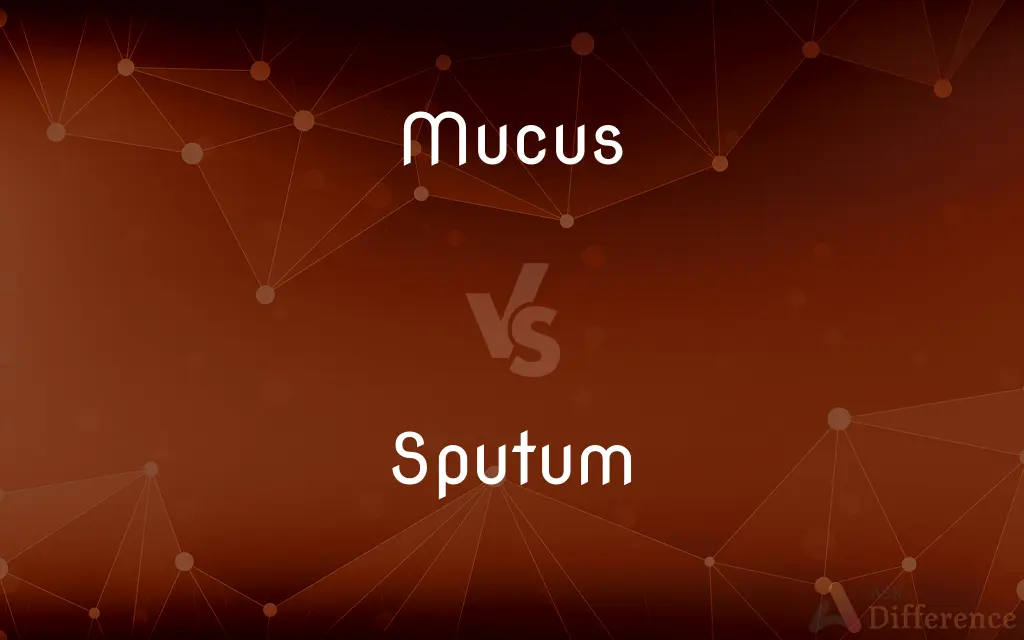Mucus vs. Sputum — What's the Difference?
By Fiza Rafique & Maham Liaqat — Updated on April 26, 2024
Mucus is a slippery secretion from mucous membranes, aiding in lubrication and protection, whereas sputum, a type of mucus, is specifically coughed up from the respiratory tract.

Difference Between Mucus and Sputum
Table of Contents
ADVERTISEMENT
Key Differences
Mucus is produced by mucous membranes lining various body cavities, including the nose, throat, and lungs. It serves as a protective barrier against pathogens and particles. On the other hand, sputum is mucus that is specifically expelled from the lower airways (trachea and lungs) during coughing, often containing cells, dust, and microbes.
While mucus is generally clear and thin, facilitating the trapping and movement of particles out of the body, sputum can vary in color and consistency, indicating specific health conditions. For example, yellow or green sputum may suggest a bacterial infection.
Mucus production is a continuous and normal body function, critical for maintaining the health of mucous membranes. In contrast, the production of sputum is often increased by respiratory illnesses or conditions such as bronchitis, pneumonia, or chronic obstructive pulmonary disease (COPD).
Furthermore, mucus serves various functions across different parts of the body, such as aiding in digestion within the stomach and intestines. Sputum, however, is solely involved in respiratory functions, helping to clear unwanted materials from the lungs.
The study and analysis of sputum can provide valuable diagnostic insights into respiratory health, revealing infections, allergies, or other issues. Mucus, while generally less specific in diagnosis, is crucial in everyday protection against dehydration, bacteria, and viruses.
ADVERTISEMENT
Comparison Chart
Definition
A viscous secretion from mucous membranes.
Mucus that is coughed up from the respiratory tract.
Production Location
Throughout the body’s mucous membranes.
Specifically in the lower respiratory tract.
Color and Consistency
Typically clear and thin.
Can be clear, yellow, green, or cloudy, depending on health.
Function
Lubrication and protection against pathogens.
Expulsion of debris and pathogens from the lungs.
Health Indications
Usually indicates normal bodily functions.
Can indicate respiratory conditions or infections.
Compare with Definitions
Mucus
A lubricating and protective secretion from mucous membranes.
Mucus in the nose helps trap dust and microbes.
Sputum
Indicates respiratory system’s response to infection.
Increased sputum production is seen in bronchitis.
Mucus
Produced by goblet cells and mucous glands.
Mucus secretion increases during a cold.
Sputum
Often studied in labs to detect respiratory diseases.
Sputum samples are tested for tuberculosis.
Mucus
Aids in the movement of materials and cells through the body.
Mucus helps transport swallowed food down the esophagus.
Sputum
Mucus material coughed up from the lungs.
Analyzing sputum can help diagnose a lung infection.
Mucus
A clear, viscous fluid that coats and protects internal body surfaces.
Mucus on the stomach lining protects it from acid.
Sputum
Can contain blood, bacteria, or viral particles.
Blood in sputum may indicate serious respiratory issues.
Mucus
Vital for maintaining moisture in the respiratory system.
Mucus ensures the airways remain moist and functional.
Sputum
Varied in color, indicating different health states.
Green sputum often suggests a bacterial infection.
Mucus
Mucus ( MEW-kəs) is a slippery aqueous secretion produced by, and covering, mucous membranes. It is typically produced from cells found in mucous glands, although it may also originate from mixed glands, which contain both serous and mucous cells.
Sputum
Sputum is mucus that is coughed up from the lower airways (the trachea and bronchi). In medicine, sputum samples are usually used for naked eye exam, microbiological investigations of respiratory infections and cytological investigations of respiratory systems.
Mucus
The viscous, slippery substance that consists chiefly of mucin, water, cells, and inorganic salts and is secreted as a protective lubricant coating by cells and glands of the mucous membranes.
Sputum
Matter coughed up and usually ejected from the mouth, including saliva, foreign material, and substances such as mucus or phlegm, from the respiratory tract.
Mucus
(physiology) A slippery secretion from the lining of the mucous membranes.
Sputum
(physiology) Matter coughed up and expectorated from the mouth, composed of saliva and discharges from the respiratory passages such as mucus, phlegm or pus.
Mucus
A viscid fluid secreted by mucous membranes, which it serves to moisten and protect. It covers the lining membranes of all the cavities which open externally, such as those of the mouth, nose, lungs, intestinal canal, urinary passages, etc.
Sputum
That which is expectorated; a salival discharge; spittle; saliva.
Mucus
Any other animal fluid of a viscid quality, as the synovial fluid, which lubricates the cavities of the joints; - improperly so used.
Sputum
Expectorated matter; saliva mixed with discharges from the respiratory passages; in ancient and medieval physiology it was believed to cause sluggishness
Mucus
A gelatinous or slimy substance found in certain algæ and other plants.
Mucus
Protective secretion of the mucous membranes; in the gut it lubricates the passage of food and protects the epithelial cells; in the nose and throat and lungs it can make it difficult for bacteria to penetrate the body through the epithelium
Common Curiosities
How does sputum differ from other forms of mucus?
Sputum is specifically coughed up from the lungs and may indicate respiratory issues.
What does clear mucus indicate?
Clear mucus is normal and indicates healthy mucous membranes.
What is the primary function of mucus?
Mucus primarily lubricates and protects mucous membranes from pathogens.
Can analyzing sputum diagnose diseases?
Yes, sputum analysis can help diagnose respiratory conditions like tuberculosis or pneumonia.
Why is mucus important in the digestive system?
It protects the lining of the digestive tract from stomach acid and enzymes.
What conditions can increase mucus production?
Conditions like colds, allergies, and sinus infections can increase mucus production.
What are the consequences of reduced mucus production?
Reduced mucus production can lead to dry membranes and increased infection risk.
Can the color of sputum indicate health problems?
Yes, the color of sputum, such as yellow or green, can indicate infections.
Why is mucus in the respiratory system important?
It traps and helps remove particles and pathogens from the airways.
What does green sputum indicate?
Green sputum often indicates a bacterial infection in the respiratory tract.
How does the body produce mucus?
Mucus is produced by goblet cells and mucous glands throughout the body.
Is sputum production normal in healthy individuals?
Healthy individuals might produce small amounts, but significant sputum production usually suggests illness.
What role does mucus play in the body's immune response?
Mucus traps pathogens and facilitates their removal from the body, aiding the immune response.
Can the consistency of mucus change?
Yes, it can become thicker or thinner depending on hydration levels and health conditions.
What should be done if sputum production is excessive?
Excessive sputum production should be evaluated by a healthcare provider to diagnose potential underlying conditions.
Share Your Discovery

Previous Comparison
Toboggan vs. Beanie
Next Comparison
Colloquialism vs. IdiomAuthor Spotlight
Written by
Fiza RafiqueFiza Rafique is a skilled content writer at AskDifference.com, where she meticulously refines and enhances written pieces. Drawing from her vast editorial expertise, Fiza ensures clarity, accuracy, and precision in every article. Passionate about language, she continually seeks to elevate the quality of content for readers worldwide.
Co-written by
Maham Liaqat












































